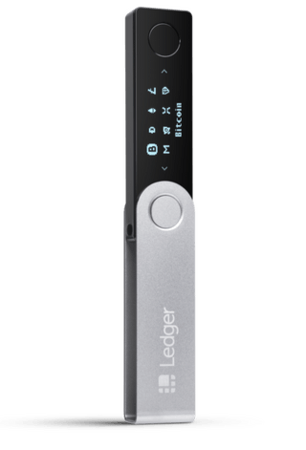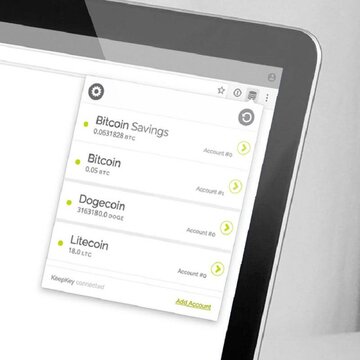Stress-Free Security
In addition, there have also been reports that the customer support team is relatively slow to resolve these issues. Other than connectivity, no issues related to security have been reported on social media or online forums.
On the top of the Hardware Wallet there is a large OLED display on which the transmission of data such as private keys can be traced precisely. Cryptos can also be changed directly on the device using Shapeshift. This means that they do not have to be transferred back to an Exchange before they can be changed.

In order to add other cryptocurrencies, there is a dropdown menu that allows users to add BCH, DOGE, LTC, ETH, plus a range of ERC20 tokens. Earlier this week I took a look at the Keepkey hardware wallet, a device that allows users to store multiple cryptocurrencies in a secure fashion. Keepkey is sold for US$129 per device, which is more expensive than the Ledger Nano, Coolwallet S, and Trezor One. Nevertheless, the small rectangular device is more pleasing to hold and the screen looks very nice when the Keepkey is operating. The case the Keepkey comes in is packaged well and resembles an unopened Apple product.
The wallet’s integration with the Shapeshift exchange API enabled the capability for users to exchange their cryptocoins using the KeepKey device. Security is the most important aspect of a Wallet, which is why the Hardware Wallet can convince with its integrated security software. In addition, the device can only be unlocked via a PIN which must be entered via the display. The Hardware Wallet also scores with its compact dimensions of just 1.2 x 9.3 x 3.8 cm.
How to setup Keepkey
Unlike other hardware wallets, Keepkey needs to be plugged in to view accounts and they can’t be seen when the device is disconnected. After the initial seed had been set up, I created a bitcoin cash (BCH) wallet to send myself some funds. Anytime I test a new wallet I always send a small fraction of crypto just to make sure the application is working properly. The wallet immediately saw the transaction; you can view confirmed and unconfirmed transactions in a separate window that’s tethered to a block explorer.
A Hardware Wallet That’s As Serious About Crypto As You Are
The Keepkey Hardware Wallet is a way to store private keys securely and with a significantly lower risk of attacks by third parties. The warning appears on Kraken’s latest blog post wherein it discusses a serious flaw in all of the Keepkey hardware wallets. The US exchange’s security research wing claims that it has found a way to hack seeds from Keepkey wallets.
KeepKey Review Summary

Overall, KeepKey is considered a safe hardware wallet to store coins and tokens. KeepKey Wallet is one of the oldest and most secure Bitcoin hardware wallets in the world. Launched in 2015, the device is used across the world to secure digital coins and tokens. It does this with the use ofadvanced technologywhich protects customers’ funds from remote theft or cyberattacks.
The storage medium is generally connected via a USB cable. Additional batteries are not required for operation, as the device is powered via USB. Crypto practitioners who depend on Keepkey hardware wallets to store their coins ought to take a pledge of not discussing it in public. Overall, the KeepKey is a good entry level hardware wallet for users who want to store popular crypto assets such as Bitcoin or Ethereum. Although it’s limited on asset support, it’s definitely a sleek, luxury product which is satisfying to use.
In terms of security, the KeepKey has been proven secure and offers the same security guarantees as other hardware wallets on the market, so there are no concerns there. Some users will be drawn to KeepKey because of its open source firmware code, which is available for anyone to view on its GitHub. This is an advantage over Ledger, which has mostly proprietary code which users can’t fully audit themselves. KeepKey is a hardware wallet that secures bitcoin, bitcoin cash, ethereum, litecoin, dogecoin, dash and multiple erc-20 tokens. KeepKey works with the wallet software on your computer by taking over the management of private key generation, private key storage, and transaction signing.
The KeepKey presently supports the holding of Bitcoin (BTC), Ethereum (ETH, Bitcoin Cash (BCH), Litecoin (LTC), Dash (DASH), Dogecoin (DOGE), and Namecoin (NMC). Moving on, the Keepkey begins by initiating a new device name, seed and PIN. The program makes you double check the PIN twice and then asks you to write down the seed phrase, which is located on the device itself.
- Keeping your private keys offline using cold storage is the most secure way to manage your crypto.
Unlike other hardware wallets, the Keepkey does not require you to double check the 12-word phrase. After this process, you are granted access to the first account which is dedicated to BTC.
As a Hierarchical Deterministic (HD) wallet, KeepKey can be thought of as a miniature computer designed specifically for storing private keys. Even though KeepKey has recently reduced its price, it is not as popular as Trezor or Ledger Nano S. Many users have reported connectivity issues on the Reddit forum.
With the KeepKey’s associated software client, all the work of “cold storage” is done for you from any computer you need. KeepKey is a secure hardware wallet that provides access to the world’s leading cryptocurrency assets. Launched in 2015, KeepKey uses technology to provide users with a secure environment for storing their cryptocurrencies.
Different crypto currencies are generally supported by the Hardware Wallet. These include Bitcoin, Ethereum, Litecoin, Namecoin, Dogecoin and Dash. However, the manufacturer has announced that it will update the device for additional crypto currencies at regular intervals. Basically, the device is designed for Windows, Linux, Mac and Android.
Become a KeepKey Affiliate
Keepkey, Coolwallet, and the Ledger all have well-packaged boxes compared to the Trezor One packaging. Hardware wallets, like the cryptocurrency stored within them, can provoke strong emotions in their owners. Hodlers like what they like, and that’s the end of the matter. If the first hardware wallet you bought was a Ledger, you’re probably Ledger for life. Keepkey, which completes the holy trifecta of hardware wallets, is less famous than its siblings, but the sleek black plastic device still packs a punch.
There’s no argument that the ShapeShift team has done a great job of designing the KeepKey wallet. It’s a premium device, and even though it’s the largest and heaviest cryptocurrency hardware wallet by far, it feels robust and secure. Its unique design emphasizes transaction isolation, ensuring that your personal cryptocurrency treasury can’t be unwittingly compromised. The KeepKey has no operating system itself, so viruses have no attack vectors! Overall, the Keepkey operates fairly smoothly and I didn’t really have any problems throughout the setup and funding the device.
The Keepkey’s user interface is more comfortable to move around and use than the Ledger Nano, and Keepkey operates similarly to the Trezor One. Unlike the Trezor or Ledger, the Keepkey uses one button navigation but still works fluidly with the wallet’s tasks like sending and receiving. The device doesn’t have support for too many cryptocurrencies right now, and other products offer a greater selection. But as far as the coins it does hold, the Keepkey offers an easy to use operating system and is just as secure as its competitors by using similar opsec techniques.
This makes it possible, for example, to transfer private keys to the wallet via an Android smartphone. It should be noted that Google Chrome must be used to use the Hardware Wallet.
In retrospective, a seed phrase is a string of random words that allows owners to recover their cryptocurrency wallets. That said, anybody with access to seeds could gain access to cryptocurrency funds stored on a wallet.
Keeping your private keys offline using cold storage is the most secure way to manage your crypto. We think that KeepKey provides the best user experience when combined with the ShapeShift platform. On the other hand, private keys are often poorly or insufficiently protected by software developers. This allows attackers to provide the private keys with other security certificates that appear trustworthy, but are used by the attackers or hackers for their own benefit.
KeepKey is a multicurrency wallet which can hold most of the popular cryptocurrencies, including Bitcoin, Litecoin, Ethereum, Bitcoin Gold, Dash, and Dogecoin. As the wallet has been integrated with the ShapeShift cryptocurrency exchange, it is possible to exchange the digital assets directly from the device. KeepKey wallet also provides the option to recover your account in case the device is broken, stolen or lost. This pocket-sized device is an insurance policy and digital vault all in one – managing your private keys and transactions in a full-proof manner.
Following the transaction, I decided to look at the client’s Shapeshift integration. Keepkey is owned by the firm Shapeshift AG and was one of the first hardware wallets to offer trading abilities within the wallet. Recently, however, Shapeshift has changed the platform’s business model to a membership exchange and all Keepkey users have to register using the client. KeepKey works together with the wallet software on your computer by managing the private key generation, private key storage and transaction signing.
Therefore, storing the private key on an Exchange is usually not secure. Especially for larger quantities of coins, a cryptographic hardware device should be used to store the private key.
Keeping cryptocurrencies safe is a fundamental part of participating in the digital economy, and hardware wallets have become popular security solutions. These days there is a slew of devices on the market, each with its own options and features. One of these is the Keepkey wallet, a product that’s been well received by digital currency investors over the last three years.
The diversification of the different crypto currencies for which the storage medium is suitable also clearly distinguishes the device from other wallets for private keys. The Hardware Wallet is also known as the “private bitcoin vault” and is a storage medium for storing private keys for different crypto currencies.


